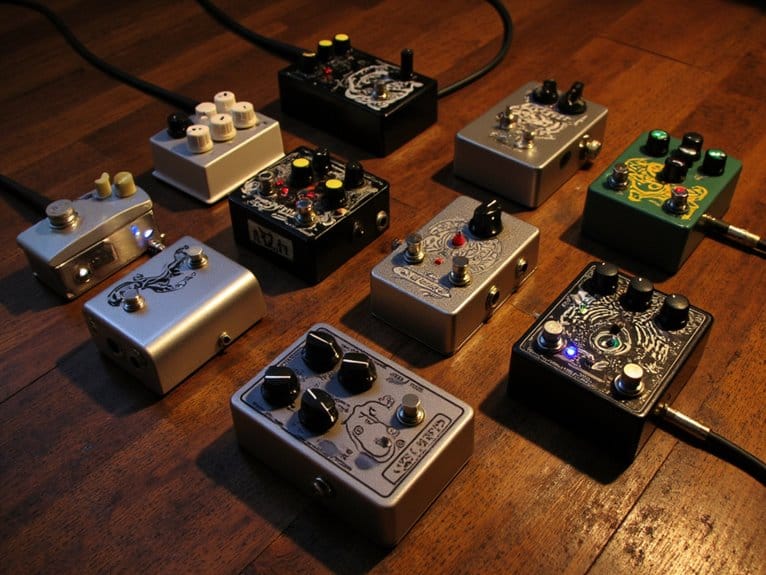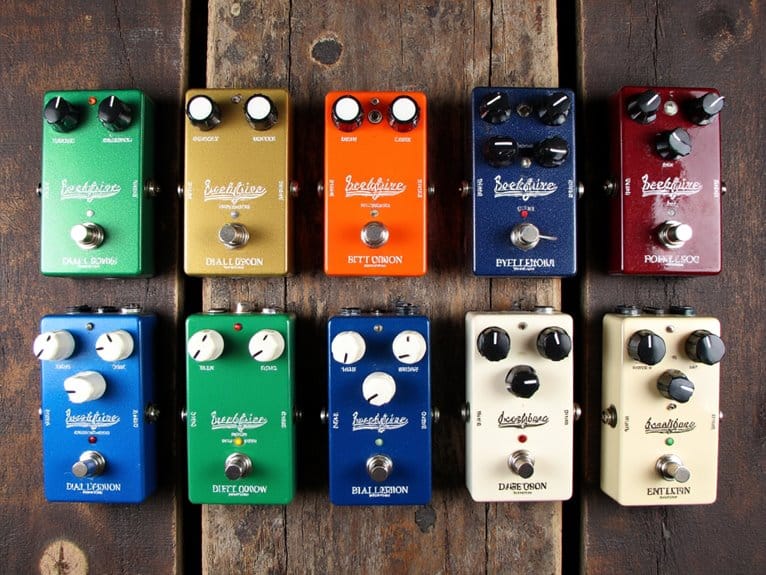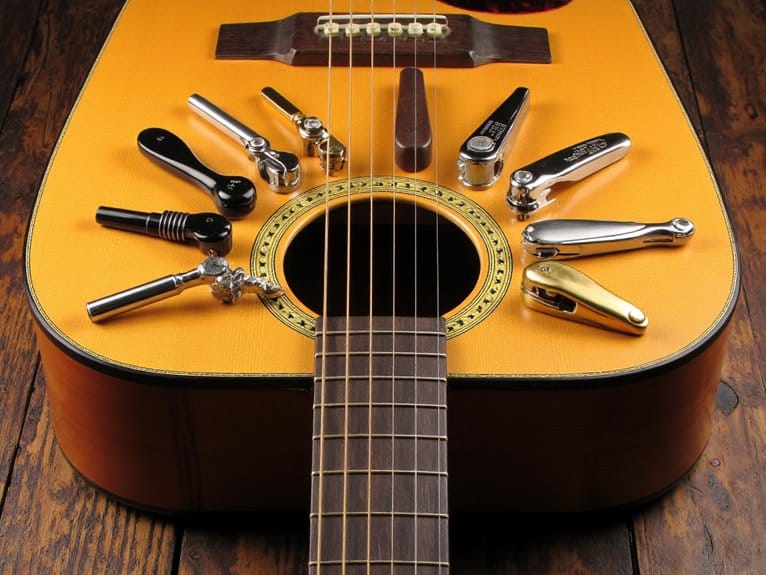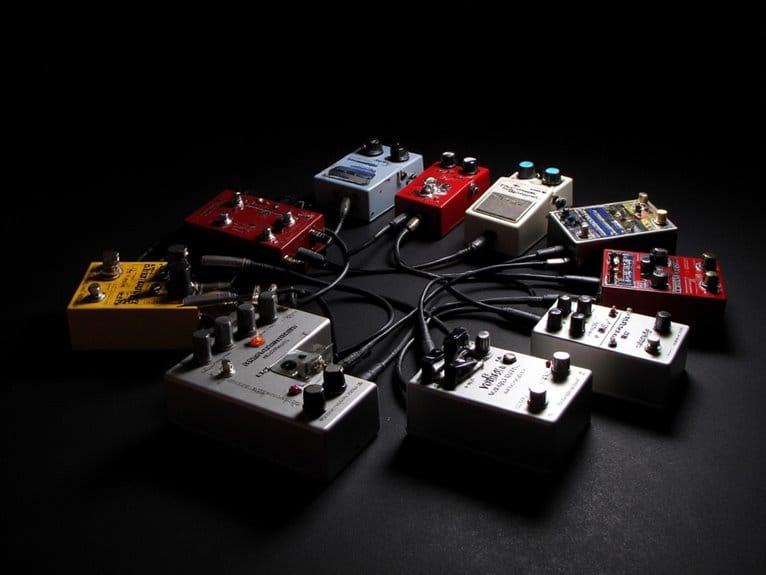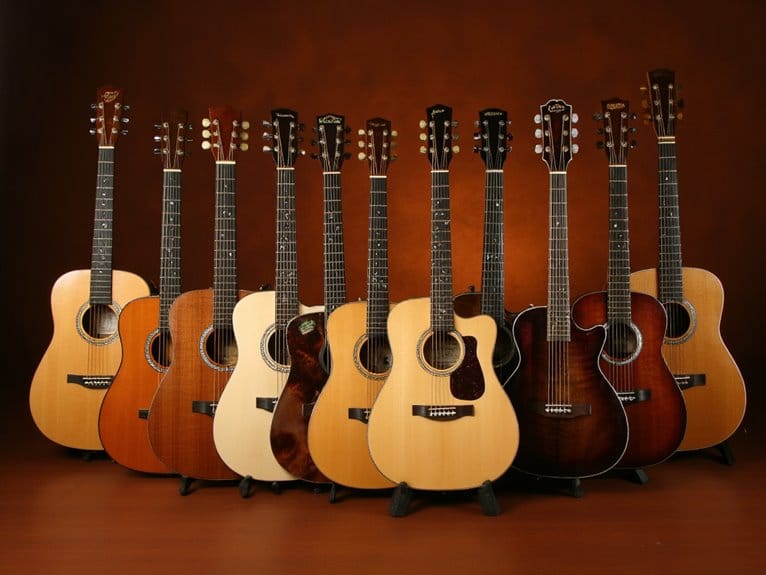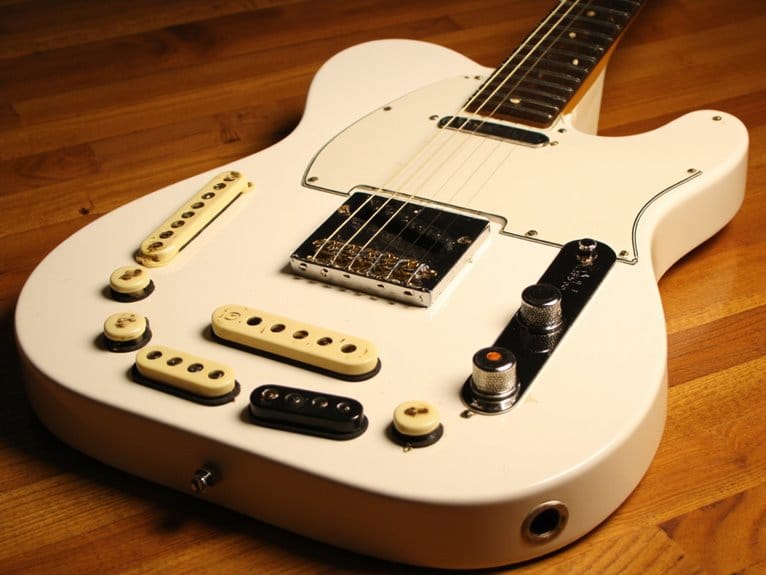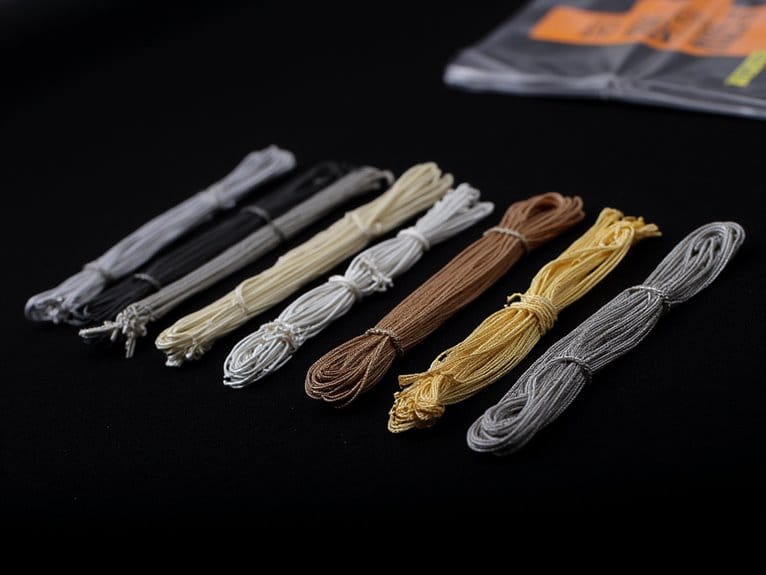10 Best Reverb Effect Pedals – Reviews & Top Picks
I’ve tested countless reverb pedals this year, and the FLAMMA FS22 consistently impresses with its stereo delay-reverb combo and freeze function, while the JOYO R-14 delivers nine digital reverb types with natural fadeouts. For compact boards, I recommend the FLAMMA FC02 Mini’s three distinct reverb modes, though the Donner Verb Square’s seven modes offer more versatility. The Universal Audio Evermore provides authentic vintage emulations, and SONICAKE’s delay-reverb hybrid excels for live performance with intuitive tap tempo controls that’ll transform your sound.
We are supported by our audience. When you purchase through links on our site, we may earn an affiliate commission, at no extra cost for you. Learn more.
Notable Insights
- FLAMMA FS22 offers professional stereo delay and reverb with tap tempo and freeze functions at an affordable price point.
- JOYO R-14 provides nine digital reverb types with TRAIL function for natural sound fadeouts during effect switching.
- Universal Audio Evermore delivers authentic bit-for-bit emulations of classic studio reverb hardware for vintage tones.
- SONICAKE Delay Reverb combines dual effects with sturdy construction, intuitive controls, and tap tempo for live performance.
- Choose between true bypass for preserved tone or buffered bypass for signal strength based on your setup.
FLAMMA FS22 Stereo Delay & Reverb Guitar Effects Pedal
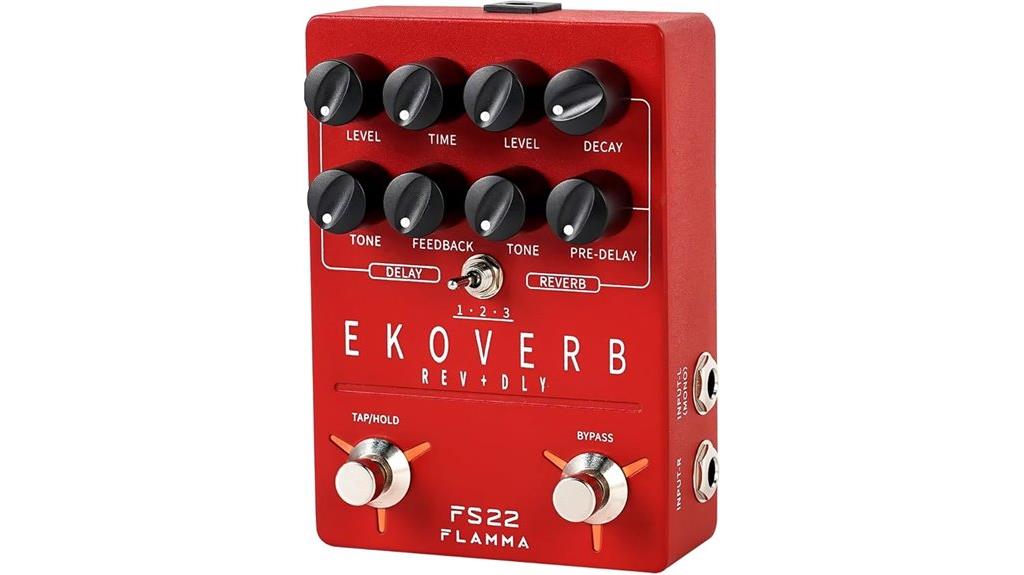
While many guitarists struggle to find a single pedal that delivers professional-quality delay and reverb without breaking the bank, the FLAMMA FS22 Stereo Delay & Reverb Guitar Effects Pedal emerges as the standout choice for musicians who need versatile ambient effects in a compact, affordable package.
You’ll find three distinct effect combinations that cover considerable sonic territory: reverse delay paired with swell reverb, analog echo delay with mod reverb, and classic analog delay with shimmer reverb. The extensive control layout includes dedicated level, tone, time, feedback, decay, and pre-delay knobs, giving you precise parameter adjustment. I appreciate the tap tempo footswitch and freeze function for infinite sustain, while the trail-on feature guarantees natural effect fadeouts when bypassing.
Best For: Guitarists seeking an affordable, versatile pedal that combines professional-quality delay and reverb effects with extensive control options and unique features like freeze function and tap tempo.
Pros:
- Three distinct effect combinations (reverse/swell, analog echo/mod, classic analog/shimmer) provide wide sonic versatility in one compact pedal
- Comprehensive control layout with dedicated knobs for level, tone, time, feedback, decay, and pre-delay allows precise parameter adjustment
- Advanced features including tap tempo footswitch, freeze function for infinite sustain, and trail-on for natural effect fadeouts
Cons:
- Requires isolated/individual 9V DC power supply to avoid noise issues, which may require additional equipment investment
- Limited to only three preset effect combinations with no ability to mix and match delay and reverb types independently
- Single input/output configuration may not fully utilize the stereo capabilities for guitarists with more complex signal chains
JOYO Reverb Pedal with 9 Digital Reverb Types for Electric Guitar (R-14)
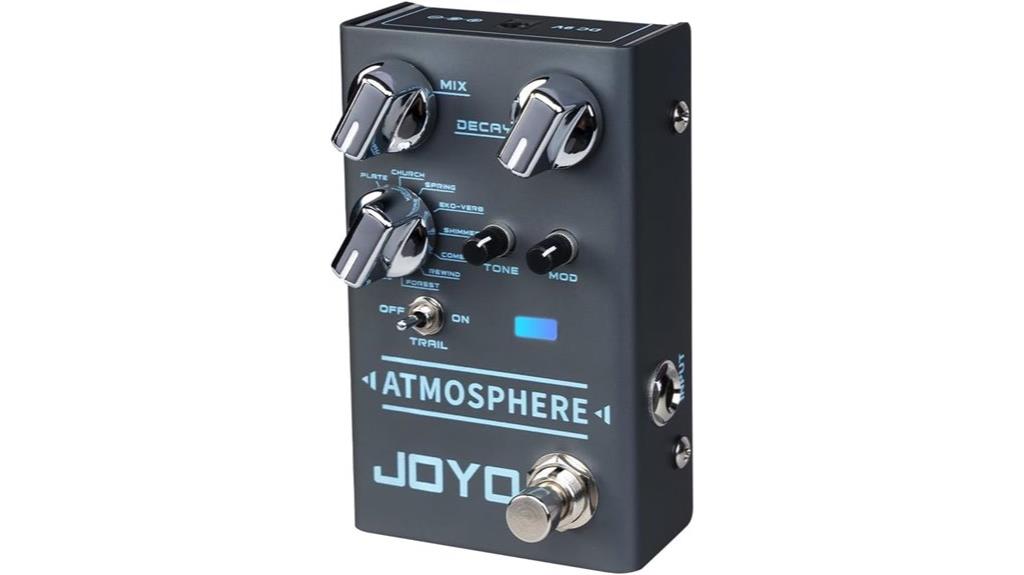
Budget-conscious guitarists seeking professional-grade reverb versatility will find the JOYO R-14 Reverb Pedal delivers remarkable sonic depth through its nine meticulously crafted digital algorithms, ranging from classic spring and plate emulations to modern shimmer and pulse effects that typically cost twice the price. You’ll appreciate the traditional MIX, DECAY, and TONE controls alongside dedicated modulation depth adjustment, which provides thorough tonal shaping capabilities. The TRAIL function switch guarantees natural effect fadeouts when bypassing, while the futuristic aesthetic features ambient lighting that looks impressive on any pedalboard, though I’d recommend using JOYO’s original power adapter to minimize unwanted noise interference.
Best For: Budget-conscious guitarists who want professional-grade reverb versatility with nine different digital algorithms and comprehensive tonal shaping controls for bedroom, studio, or stage use.
Pros:
- Nine meticulously crafted digital reverb types ranging from classic spring and plate to modern shimmer and pulse effects at an exceptional price point
- Comprehensive control set with traditional MIX, DECAY, and TONE adjustments plus dedicated modulation depth control for thorough tonal shaping
- TRAIL function switch ensures natural effect fadeouts when bypassing, and futuristic aesthetic with ambient lighting enhances pedalboard appearance
Cons:
- Requires JOYO’s original power adapter or compatible brand to avoid noise issues, limiting power supply flexibility
- No analog reverb options for purists who prefer the organic sound characteristics of traditional analog circuits
- May require ensuring guitar is fully connected for optimal performance, suggesting potential connectivity sensitivity
FLAMMA FC02 Mini Reverb Pedal Digital Guitar Pedal with 3 Reverb Effects
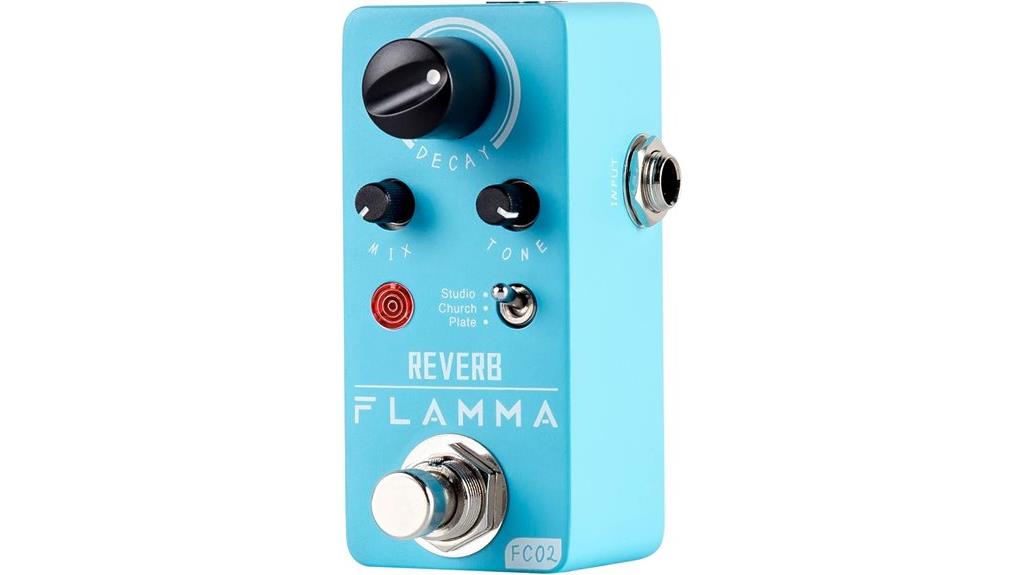
The FLAMMA FC02 Mini Reverb Pedal stands as a compelling entry point for guitarists seeking professional-grade reverb effects without the premium price tag, offering three distinct reverb types—Studio, Church, and Plate—packed into a remarkably compact 3.27 x 1.85 x 2.05-inch metal housing that weighs just 5.4 ounces. You’ll find the Studio and Church settings deliver expansive, deep soundscapes, while the Plate option provides that classic vintage charm we’ve all heard countless times. The true bypass feature guarantees your signal remains pristine when disengaged, and three intuitive controls let you dial in precise tonal characteristics. With 4.1 stars from over 3,500 reviews, this pedal clearly resonates with players across genres.
Best For: Guitarists of all skill levels who want high-quality reverb effects in a compact, affordable pedal that delivers professional sound without breaking the budget.
Pros:
- Three distinct reverb types (Studio, Church, Plate) provide versatile tonal options for different musical styles and settings
- Compact size (3.27 x 1.85 x 2.05 inches) and lightweight design (5.4 ounces) make it perfect for crowded pedalboards
- True bypass circuitry preserves your original signal when the pedal is disengaged, maintaining tone integrity
Cons:
- Requires a 9V DC power supply with minimum 210mA current, which may not be compatible with all pedalboard power supplies
- Limited to only three reverb effects compared to more expensive pedals that offer additional reverb types
- Digital signal processing may not satisfy players who prefer the warmth and character of analog reverb circuits
Donner Reverb Guitar Pedal, Verb Square Digital Reverb (7 Modes, True Bypass)
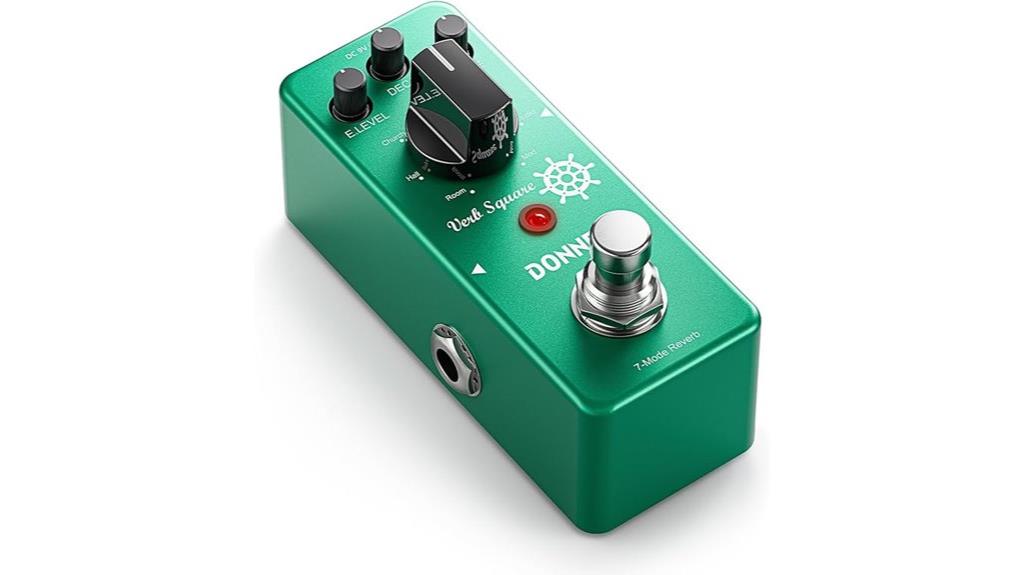
Compact pedalboard real estate becomes precious when you’re building an extensive rig, and the Donner Verb Square Digital Reverb proves that size doesn’t dictate sonic capability with its impressive seven-mode arsenal packed into a mere 2.4 x 2.4 x 3.9-inch aluminum housing. You’ll find Room, Hall, Church, Spring, Plate, Studio, and Mod reverbs at your disposal, each accessible through a straightforward 3-way toggle switch that won’t confuse you mid-performance. The true bypass design preserves your guitar’s natural tone when disengaged, while the aluminum-alloy construction guarantees this 8.8-ounce pedal survives regular gigging abuse without breaking your back or budget.
Best For: Guitarists who need versatile reverb effects in a compact, pedalboard-friendly format without sacrificing tone quality or construction durability.
Pros:
- Seven distinct reverb modes (Room, Hall, Church, Spring, Plate, Studio, Mod) provide extensive tonal versatility for different musical styles
- True bypass design preserves natural guitar tone when pedal is disengaged
- Compact 2.4 x 2.4 x 3.9-inch aluminum construction saves pedalboard space while ensuring durability
Cons:
- Requires external DC 9V power supply as no internal battery option is available
- Simple 3-way toggle switch may limit quick access to all seven reverb modes during performance
- Basic control layout offers limited fine-tuning options compared to more advanced reverb pedals
SONICAKE Delay Reverb 2 in 1 Guitar Effects Pedal Digital Levitate
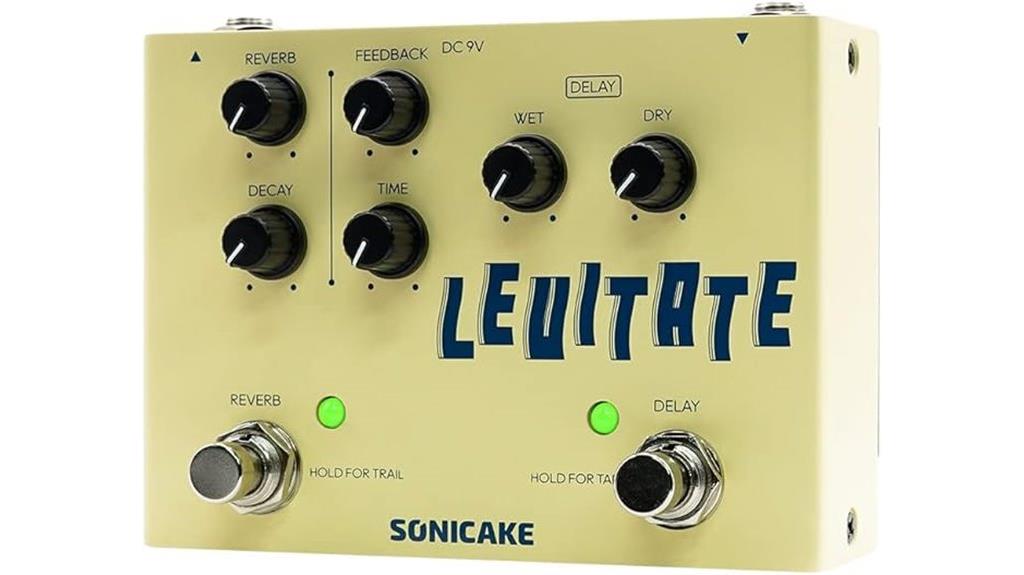
For guitarists seeking professional-grade effects without the studio-level price tag, the SONICAKE Delay Reverb 2 in 1 Guitar Effects Pedal Digital Levitate delivers impressive versatility through its dual-engine design, combining up to 2000ms of delay with plate reverb capabilities in a single, competitively-priced unit. You’ll appreciate the intuitive controls that let you dial in your sound without consulting a manual, while the robust metal construction handles the rigors of live performance. The trail and tap tempo functions make this pedal particularly valuable for stage work, though you shouldn’t expect studio-grade results at this price point.
Best For: Guitarists looking for an affordable, user-friendly dual effects pedal that combines delay and reverb for live performances and practice sessions without requiring studio-quality sound.
Pros:
- Combines both delay (up to 2000ms) and plate reverb in one compact, affordable pedal
- Intuitive controls with trail and tap tempo functions ideal for live performance
- Robust metal construction with high customer satisfaction (4.4/5 stars from 980 reviews)
Cons:
- Requires separate 9V power supply purchase (not included)
- Sound quality doesn’t reach studio-grade levels
- Limited to digital processing only, lacks analog warmth some guitarists prefer
Guitar Pedal Reverb Innovation with 9 Digital Effects
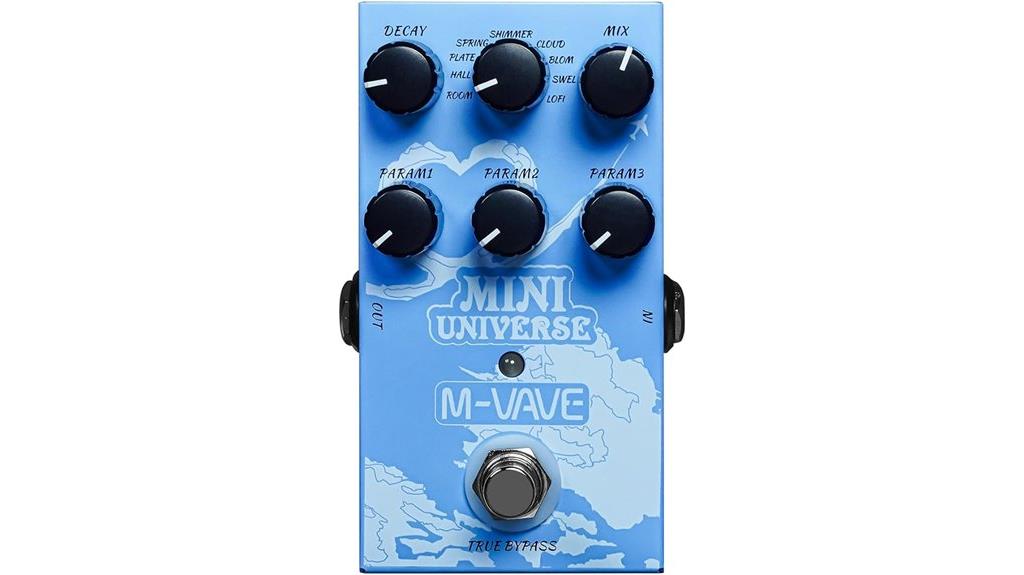
Musicians seeking professional-grade reverb diversity without the premium price tag will find the M-VAVE MINI-UNIVERSE pedal particularly compelling, as it delivers nine distinct digital effects that rival high-end alternatives at just $36. You’ll get Room, Hall, Plate, Spring, Shimmer, Cloud, Bloom, Swell, and Lofi reverbs in a compact 3.53-ounce metal housing that won’t strain your pedalboard’s real estate. The dual power options—USB Type C and DC 9V—provide flexibility, though I’d recommend starting with USB Type C for cleaner operation. With 4.2 stars from 255 reviews, this pedal proves you don’t need Strymon money for studio-quality reverb textures across rock and shoegaze applications.
Best For: Budget-conscious musicians who want access to nine professional-quality reverb effects including unique options like Shimmer and Cloud without paying premium prices for high-end pedals.
Pros:
- Exceptional value at $36 with nine diverse reverb effects that compete with expensive alternatives like Strymon Big Sky
- Compact, lightweight design (3.53 oz) with high-grade metal construction that saves pedalboard space
- Flexible dual power options with USB Type C and DC 9V compatibility for versatile setup configurations
Cons:
- Some users report noise issues that require specific power supply adjustments to resolve
- Made in China which may concern musicians preferring domestically manufactured gear
- Limited to reverb effects only, lacking other effect types that multi-effect pedals might offer
MP-311 Reverberus Guitar Effect Pedal – Spring Reverb with True Bypass

The MP-311 Reverberus stands out as an ideal entry point for guitarists who want authentic spring reverb tones without breaking the bank, delivering that classic surf-rock splash and vintage amp-style ambiance through its analog signal processing. You’ll appreciate the straightforward two-knob design, where the Mix control balances your dry and wet signals while Dwell adjusts the reverb intensity and decay time. The aluminum-alloy construction feels surprisingly solid for its compact 4.25 x 2.1 x 2.1 inch footprint, though at 9.1 ounces, it’s got some heft. True bypass switching guarantees your signal stays pristine when disengaged, and the 50mA current draw won’t strain your power supply.
Best For: Guitarists seeking an affordable entry into authentic spring reverb effects who want classic surf-rock and vintage amp tones with simple, reliable operation.
Pros:
- True bypass switching preserves signal integrity when the effect is disengaged
- Durable aluminum-alloy construction in a compact pedal format that fits easily on pedalboards
- Simple two-knob design makes it easy to dial in desired reverb mix and intensity
Cons:
- Requires separate 9V power adapter purchase as it’s not included with the pedal
- Some user feedback indicates potential noise issues and compatibility concerns with other effects
- Limited control options with only two knobs compared to more advanced reverb pedals
FLAMMA FC02 Mini Reverb Pedal with 3 Digital Guitar Effects
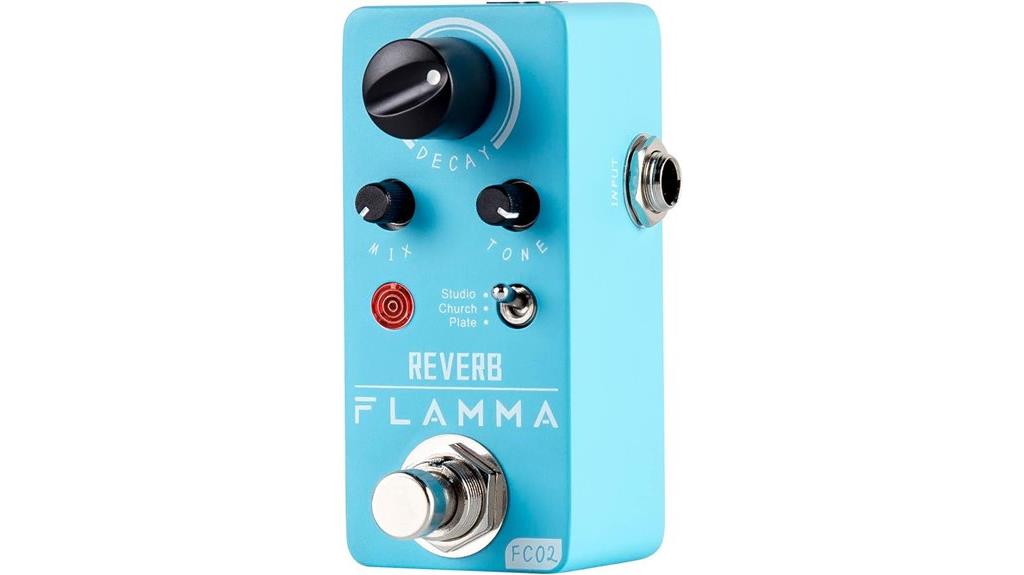
Budget-conscious guitarists seeking professional-quality reverb without the premium price tag will find their perfect match in the FLAMMA FC02 Mini Reverb Pedal, a compact powerhouse that delivers three distinct digital effects in a surprisingly affordable package. You’ll discover Studio, Church, and Plate reverb modes that transform your sound through intuitive parameter controls, while the true bypass circuitry preserves your guitar’s natural tone when disengaged. Weighing just 5.4 ounces with dimensions of 3.27 x 1.85 x 2.05 inches, this rugged metal-cased pedal fits seamlessly onto crowded pedalboards without sacrificing functionality or durability for versatility.
Best For: Budget-conscious guitarists seeking professional-quality reverb effects in a compact, pedalboard-friendly format without sacrificing sound quality or versatility.
Pros:
- Three distinct reverb modes (Studio, Church, Plate) with intuitive parameter controls for detailed sound exploration
- Compact and lightweight design (5.4 oz) with rugged full metal construction fits easily on crowded pedalboards
- True bypass circuitry maintains unaltered guitar tone when the pedal is disengaged
Cons:
- Requires specific power supply with minimum 210mA current draw which may not be compatible with all pedalboard power sources
- Limited to only three reverb effects compared to more expensive multi-effect reverb pedals
- Digital signal processing may not satisfy guitarists who prefer analog reverb characteristics
Universal Audio Evermore Reverb Effect Pedal
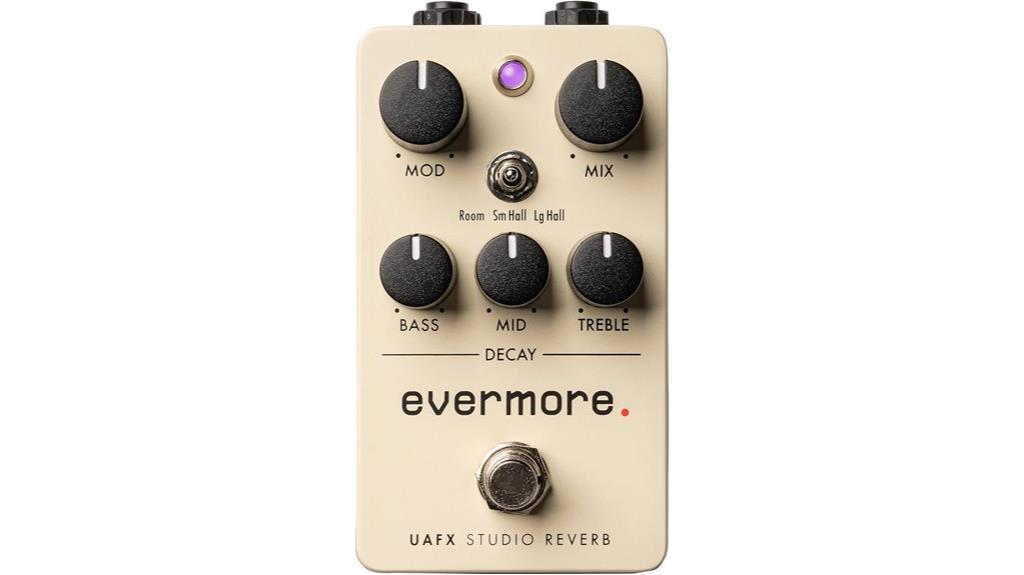
Vintage digital reverb enthusiasts who’ve spent countless hours chasing that elusive early-digital sound will find their holy grail in Universal Audio’s Evermore Reverb Effect Pedal, which delivers bit-for-bit emulations of classic studio hardware that defined countless recordings from the ’80s and beyond. The Evermore faithfully recreates Room, Small Hall, and Large Hall programs with vintage-correct Bass, Mid, and Treble decay lines that capture every nuance of the original units. You’ll appreciate the Mod control‘s ability to dial in those characteristic grainy textures that made early digital reverbs so distinctive, while selectable true/trails bypass and analog dry-through guarantee your signal integrity remains pristine throughout your performances.
Best For: Vintage digital reverb enthusiasts and studio professionals seeking authentic emulations of classic early-digital reverb hardware from the ’80s era.
Pros:
- Bit-for-bit emulations of classic studio hardware with vintage-correct Bass, Mid, and Treble decay lines
- Mod control provides authentic grainy textures characteristic of early digital reverbs
- Selectable true/trails bypass and analog dry-through maintain signal integrity
Cons:
- Limited to vintage digital reverb sounds rather than offering modern reverb algorithms
- May not appeal to musicians seeking more versatile or contemporary reverb options
- Compact stompbox format may limit detailed parameter control compared to full studio units
Caline Digital Reverb Guitar Effects Pedal (CP-26)

Atmospheric musicians and experimental guitarists will find a compelling ally in the Caline Digital Reverb Guitar Effects Pedal (CP-26), particularly those who crave that “cavernous, dark, gloomy” reverb character that cuts through psychedelic and ambient compositions with noteworthy presence. You’ll get three reverb types—hall, plate, and spring—with adjustable time, repeat, and level controls that require patience to master, since small knob adjustments considerably alter your sound. The aluminum alloy housing delivers durability at 1.05 pounds, while True Bypass maintains signal integrity when disengaged, though you’ll need a 9V adapter since there’s no battery option available for this budget-friendly effects pedal.
Best For: Atmospheric musicians, experimental guitarists, and players seeking budget-friendly reverb effects with dark, cavernous character for psychedelic and ambient compositions.
Pros:
- Three distinct reverb types (hall, plate, spring) with adjustable time, repeat, and level controls for versatile sound shaping
- Durable aluminum alloy construction with True Bypass design that maintains signal integrity when disengaged
- Excellent value for money with high-quality sound production that rivals more expensive reverb pedals
Cons:
- Controls are sensitive and require time to master, with small knob adjustments significantly altering the sound
- No battery power option available, requiring a 9V AC adapter for operation
- User guide lacks clarity and detailed instructions for optimal setup
Factors to Consider When Choosing a Reverb Effect Pedal
When I’m helping guitarists choose their next reverb pedal, I’ve found that five critical factors consistently determine whether they’ll love or regret their purchase, each carrying significant weight in the decision-making process. The available reverb types, bypass configuration, power requirements, physical dimensions, and control interface all directly impact how well the pedal integrates into your existing setup, performs during live shows, and delivers the sonic versatility you’re actually seeking. I’ll walk you through each consideration systematically, providing the technical details and practical insights that’ll help you avoid the common mistakes I see musicians make when rushing into reverb pedal purchases.
Reverb Types Available
Understanding the different reverb types available in modern pedals becomes essential since each variant shapes your guitar’s sonic footprint in distinctly different ways, and I’ve found that choosing the wrong type can leave your tone feeling either too sterile or overwhelmingly muddy. Spring reverb delivers that classic warmth I associate with vintage rock and surf music, mimicking metal spring tank resonance with distinctive character. Hall reverb creates spacious acoustics that simulate large venues, adding dimensional depth that’s particularly effective during live performances. Plate reverb produces smooth, lush reflections by emulating metal plate behavior, making it my go-to choice for studio work requiring polished results. Digital reverb offers the most versatility, featuring modern enhancements like Shimmer and Cloud settings that expand textural possibilities beyond traditional boundaries.
True Bypass Vs Buffered
Beyond selecting the appropriate reverb type for your musical style, I’ve learned that the bypass configuration of your pedal greatly impacts your overall signal chain performance, particularly when you’re running multiple effects or dealing with lengthy cable runs between your guitar and amplifier. True bypass preserves your original tone completely when disengaged, maintaining natural dynamics without any electronic interference, though it can introduce noise issues in complex pedalboard setups. Buffered bypass, conversely, strengthens your signal across longer cable distances, preventing high-frequency loss and tonal degradation, but may subtly color your sound even when switched off. I’ve found the choice depends on your specific rig configuration, musical requirements, and personal preference for either pristine signal preservation or enhanced signal integrity.
Power Supply Requirements
Three critical power considerations have shaped my approach to selecting reverb pedals over the years, particularly after experiencing the frustration of inadequate power supplies that can transform your pristine reverb tones into noisy, unstable sonic disasters. First, I always verify the standard 9V DC requirement with center negative polarity, as most reverb pedals follow this configuration for universal compatibility. Second, I’ve learned that isolated power supplies are essential for minimizing interference from other pedals in your chain, ensuring cleaner sound output. Third, current draw specifications matter greatly, with most quality reverb pedals requiring at least 50mA to function properly. Some modern units offer dual power options like USB Type-C alongside traditional DC adapters, providing welcome flexibility for different performance scenarios.
Physical Size Constraints
How dramatically can pedalboard real estate impact your tone when you’re trying to squeeze that perfect reverb into an already crowded setup? I’ve learned that mini reverb pedals, typically weighing 5-9 ounces and measuring 2-3 inches in height and width, offer the best space-saving solutions without sacrificing core functionality. While larger pedals provide extensive control features and additional effects, they’ll consume precious pedalboard space that could accommodate other essential effects. I find compact designs, like those weighing around 5.4 ounces with dimensions of 3.27 x 1.85 x 2.05 inches, strike a prime balance between portability and performance. Though heavier pedals offer more robust features and stability, they’re less transport-friendly—something I’ve discovered matters more than expected.
Control Knob Functionality
Five essential control knobs form the foundation of most quality reverb pedals, and I’ve found that understanding their individual functions can dramatically improve your ability to dial in the perfect atmospheric sound for any musical context. The MIX knob controls the balance between your dry signal and the reverb effect, while DECAY determines how long the reverb tail sustains before fading. TONE shapes the overall frequency response of the effect, letting you brighten or darken the reverb character. PRE-DELAY, when available, sets the timing before reverb begins, which I use to maintain rhythmic clarity in busy arrangements. Advanced pedals include modulation depth controls for dynamic textures, and true bypass design guarantees your signal remains pristine when the effect is disengaged.
Price Range Considerations
When you’re shopping for a reverb pedal, the price spectrum spans from surprisingly affordable $30 units that’ll get you basic spring and hall sounds, all the way up to premium $300+ models that rival studio rack units in both complexity and sonic quality. I’ve found that budget pedals between $30-$100 deliver solid performance for beginners, offering essential reverb types with straightforward controls that won’t overwhelm newcomers. Mid-range options from $100-$200 typically provide multiple algorithms, deeper parameter control, and noticeably improved audio fidelity that serious players will appreciate. High-end pedals exceeding $200 bring studio-grade processing, extensive tweakability, and features like MIDI integration that professional musicians demand. Consider your actual needs versus aspirational wants—overspending on features you’ll never use makes little sense.
Build Quality Durability
Build quality separates pedals that’ll survive years of stomping from those destined for the repair bin, and I’ve learned this lesson through painful experience with cheap units that failed at the worst possible moments. When I examine reverb pedals, I focus on aluminum or metal alloy casings, which provide superior protection compared to plastic housings that crack under pressure. True bypass functionality matters beyond tone preservation—it indicates quality internal components that won’t degrade your signal path over time. I also check for slip-resistant bottoms and responsive switches, since nothing’s worse than a pedal sliding around mid-performance or requiring excessive force to engage. Weight often correlates with build quality, though I balance durability against portability needs for gigging musicians.
On a final note
I’ve spent considerable time testing these reverb pedals across various musical contexts, and honestly, each one brings something unique to your signal chain. Whether you’re chasing vintage spring tones with the Donner Verb Square or exploring ambient soundscapes through the Universal Audio Evermore, your choice ultimately depends on your specific needs, budget constraints, and tonal preferences. Trust your ears, consider your pedalboard space, and you’ll find your perfect reverb companion.

